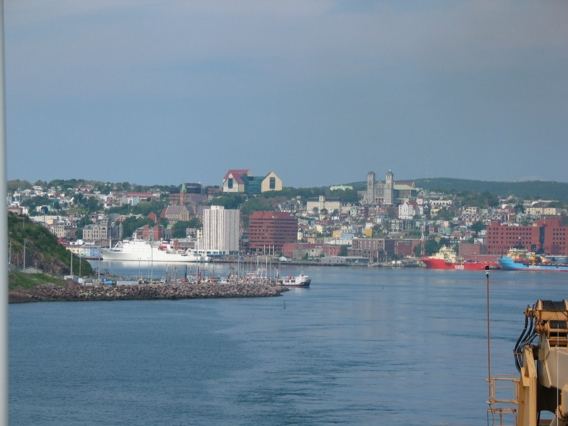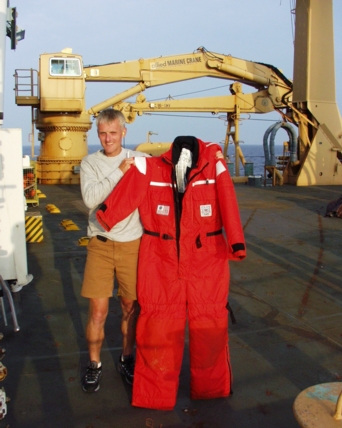|
|
Expedition
Expedition | People
|
Log - July-21-2003
by Robert McCarthy and Gerhard Behrens
Previous | Next
| First day at sea |
We are underway from St. John's, heading north, far north. We have to "steam" in this direction for about three days, over 1,000 miles. That's like driving from Portland, OR to San Diego, CA. There is not much the science crew can do at this point because all the places for experiments and collecting information are still far away. But that doesn't mean we weren't busy.
First, everyone went outside as we moved out of St. John's Harbor. Even those who have been on ships a lot loved being on deck and watched us glide away. No one was "too cool" to miss this beautiful passage into the Atlantic Ocean. |
 |
Next, we went to a ship's briefing, kind of like a class meeting. The ship's crew taught us about being responsible: taking a shower without wasting water; closing doors behind you, without letting them slam; washing full loads of laundry; sorting trash into food waste, paper, plastic, glass, and metal; flushing only toilet paper down the toilet; keeping your work and living areas clean; walking quietly in the halls; taking off hats to eat in the dining room; and asking questions. Don't those sound familiar? |
| We also learned about safety rules: where to meet in case of emergency; how to put on a survival suit; when to use an oxygen mask; how to use a pager to get a hold of someone; where to gather for life rafts; how to walk correctly on the steep and narrow stairs; when to wear steel toed boots and hard hats. Aren't their safety rules in our schools and homes? It's amazing to have so many experiences on the ship that are just like being at home or school.
|
| Today we left St. John's Newfoundland at 10:00 local time. The weather again was fantastic, and the sea state is minimal. Hence we are able to cruise at speeds of 16-18 knots. A knot is a nautical mile per hour, and a nautical mile is 1.852 km. There are 60 nautical miles (nm) in 1 degree of latitude. So based upon there being 360 degrees in a circle, calculate the circumference of the earth in km. Also given the speed in knots, determine the average speed of the ship in miles per hour. Determine the total distance traveled in 1 full day (24 hours), and then convert that number to number of degrees of latitude we can travel in one day. (Answers will appear tomorrow.) These are fairly easy calculations based upon some known conversion factors, but these occur commonly while at sea. |
 |
On a more serious side, today we were instructed on the procedures to follow for real emergencies: general emergency, collisions, man overboard, flight crash, and abandon ship. If we have to abandon ship, we are assigned to a 25 person life raft, and instructed on getting into a survival suit. We were told to eat and drink before jumping into the water (not into the life raft for fear of puncturing it) and then to conserve the supplies in the raft, not to eat or drink for 24 hours. The survival suits will keep us alive for about 3 days floating in the cold waters off of Greenland vs. about 3 hours without wearing one. They are equipped with signal flashers (for night recovery), a rectangular mirror with a small hole in the middle to reflect sunlight to passing ships or aircrafts during the day, and a loud whistle that can be heard about 1100 yards away. |
|
Also mentioned in our briefing by the crew were customs to be followed while onboard. One tradition that I had not known was that hats are not allowed to be worn while eating. This is out of respect for the dead, because during battles, the mess area became the infirmary. The food is extraordinary, and the selection amazes me. Breakfast is served from 0700-0800, lunch from 1100-1200, and dinner from 1700-1800 hours. "Mid-rats" is a term for a substantial snack time at 2300 hours. This is in case you're busy during the designated meal times, and miss a meal. There are always snacks in the mess area, and they keep them well stocked. I heard they started this cruise with a $210,000 dollar grocery bill, and now we're down to $180,000 dollars of food left. (They started the cruise in Seattle, and sailed through the Panama Canal before I boarded in St. John's Newfoundland. After I get off in Thule, Greenland, they will take the Northwest Passage and return to the west coast.)
|
|
